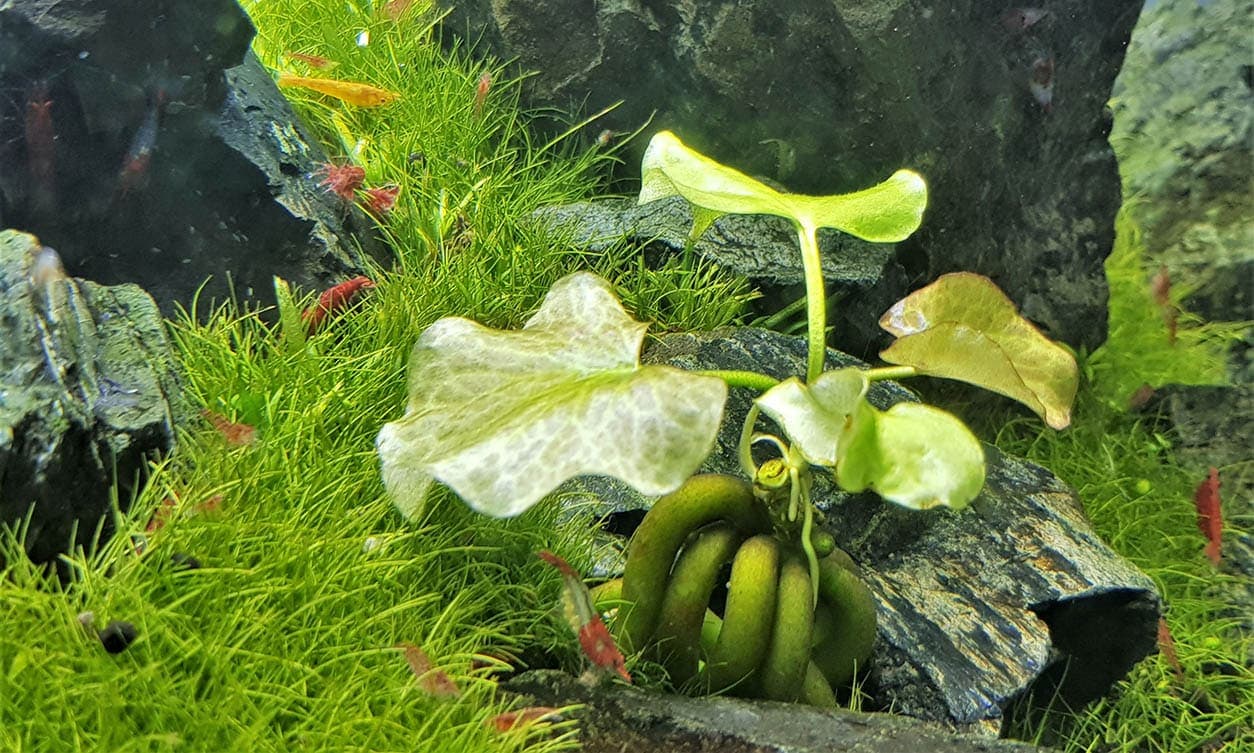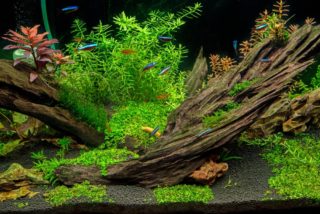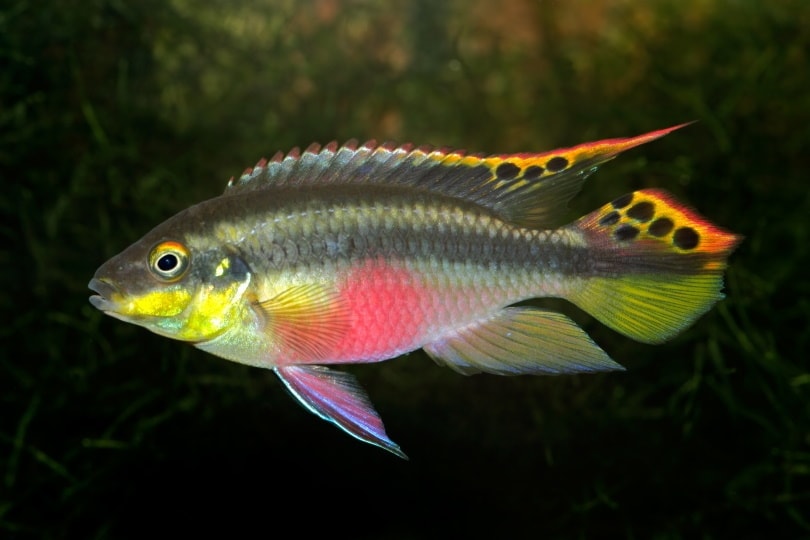Koi Fish: Types, Care Tips, Lifespan & Facts (With Pictures)

Updated on
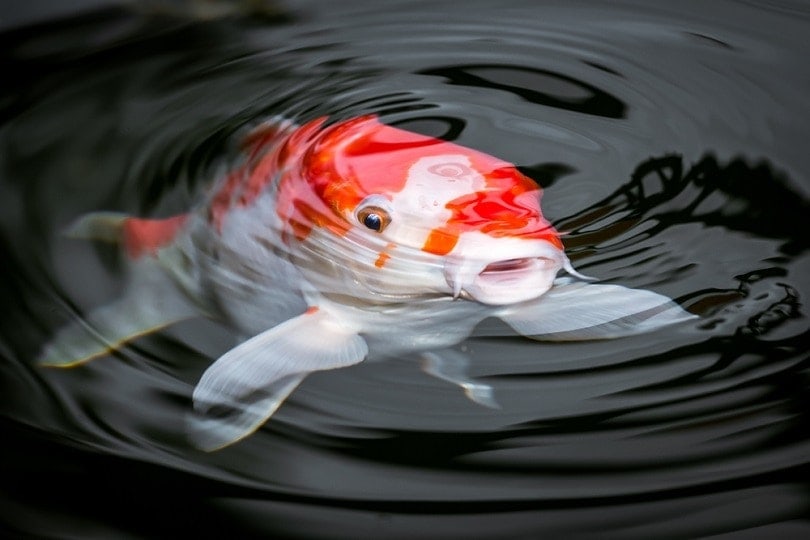
An outdoor pond populated with elegant and colorful koi fish creates a magical environment in your backyard. These peaceful giants offer a majestic and bewitching spectacle when they swim gracefully in their aquatic environment. But, although they’re hardy, koi fish do have specific needs. Discover them all in this guide, so you’ll be able to provide your fish with a long and beautiful life.
Quick Facts About Koi Fish
| Species Name: | Cyprinus rubrofuscus |
| Family: | Cyprinidae |
| Care Level: | Intermediate |
| Temperature: | 59°F to 77°F |
| Temperament: | Peaceful |
| Color Form: | Many varieties. Primary colors are white, black, red, yellow, and blue. |
| Lifespan: | 25–35 years |
| Size: | Up to 36 inches |
| Diet: | Omnivorous; detritus, algae, tank waste |
| Minimum Tank Size: | 200 gallons |
| Tank Set-Up: | Outdoor pond |
| Compatibility: | Gregarious, peaceful fish |
Koi Fish Overview
The koi fish is a fascinating ornamental species highly prized in Southeast Asia. Easily tamed and enjoying human contact, these elegant fish can measure up to 3 feet when they reach their full size. Koi fish farming is also a very ancient activity, integrated over the centuries into Chinese and Japanese culture and lifestyle. It’s now recognized and practiced in many countries and has become one of the most sophisticated and exciting areas of aquarium keeping.
Although they’re distant carp cousins, the koi fish should not be confused with a pond goldfish. Indeed, the koi carp can be distinguished by the barbs on either side of its mouth, which help it find its food in the mud. Koi fish are also known for their longevity, usually living 25 to 35 years, but some specimens have reached 70 years.
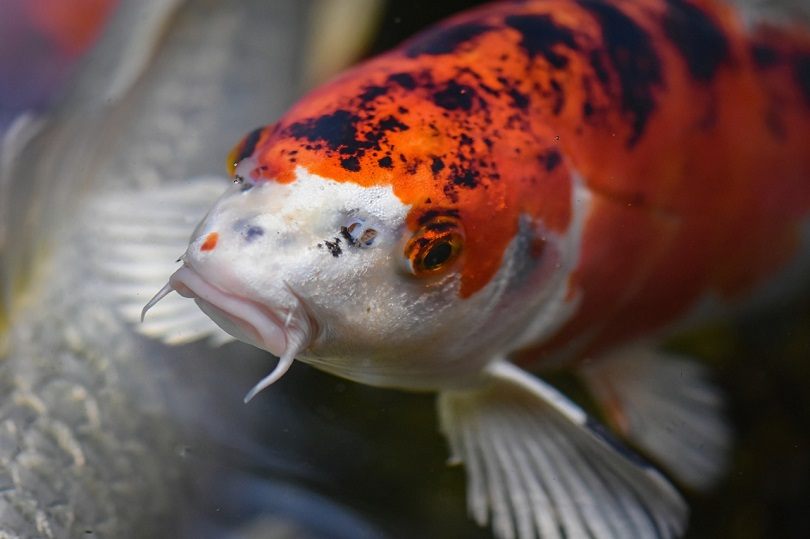
How Much Do Koi Fish Cost?
You could pay anywhere from $10 to $100, depending on the size, genetic line, origin, and variety of the koi. If you have a few extra bucks, you might splurge on a $1.8 million pet fish. Yes, you read it right. That was the price for the most expensive koi ever sold, which won the prestigious All Japan Koi Show in 2017.
While you obviously don’t need to spend that much money, you should be aware of the overall cost of raising such a pet. The construction of a habitat adapted to its specific needs can cost up to $2,000. Additionally, due to its gregarious nature, your koi will need other fish friends, which will increase the total cost.
But before purchasing a koi fish, your best bet is to go to high-rated websites, professional breeders, or specialty pet stores to seek expert advice.
Typical Behavior & Temperament
Koi fish are renowned for their docility and peaceful temperament, both with their peers and with their human parents. Also, it is possible to tame these fish. With gentleness and a little patience, your koi will feed in your hand in no time and even allow you to gently stroke them.
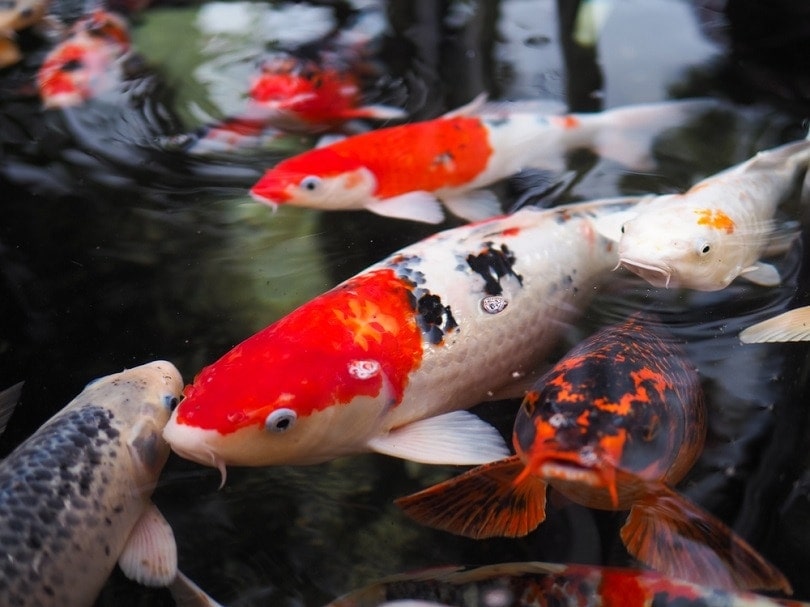
Appearance & Varieties
Koi fish are simply stunning. They are renowned for their magnificent color and patterns and the great variety among each individual. There are three main categories:
Uncolored
As the name suggests, the one-colored koi has only one hue: yellow to orange, red, and sometimes all white. This variety can cost several thousand dollars. The price is proportional to the rarity of the specimen.
Bicolored
Bicolored koi are distinguished by bright colors. You are no doubt familiar with red and white koi since they are the most common pond carp. There are also orange and white, orange and black varieties, and black and white. Of course, the beauty of each specimen is also a matter of taste; some people prefer multi-colored koi to those with a single color.
Tricolored
The last variety is the tricolor koi carp. Some have more regular spots with well-drawn outlines, while others give the impression of coming out of a coloring book for children!
Here are some of the most famous and popular varieties:
- Kohaku: All white with red spots
- Taisho-Sanke: Tricolor with a white background and red and black spots
- Showa-Sanshoku: Tricolor with black background and white and red spots
- Bekko: Bicolor
- Ki-Bekko: Yellow with black spots
- Goshiki: Magnificent specimen with black, red, white, gray, and indigo spots
- Utsurimono: Two-tone on a black background
- Asagi: Metallic reflections
- Asagi-Shusui: Bluish gray and white with red spots
- Koromo: Variety with a blue border on their scales
- Ogon: Platinum-colored variety
- Chagoi: Unicolour ranging from green to brown, light to dark. The chagoi is best known for its docility and familiarity with humans
- Kinginrin: Variety with gleaming and silvery scales
- Tancho: Variety with a red spot on the head, highly prized because it evokes the Japanese flag
How to Take Care of Koi Fish
Habitat, Tank Conditions & Setup
Your koi pond must meet certain criteria essential to the well-being of your animals.
Tank / aquarium size
Due to its size and specific needs, you should NOT keep your koi in an aquarium. It will thrive in an outdoor pond among its peers. The koi pond must have a minimum depth of 3 feet to limit the variations in water temperature over the seasons but also to allow the fish to bury themselves in the mud at the bottom of the pond during winter.
The pond should preferably be long and narrow to allow better monitoring of the health of the fish (and to enjoy the aquatic ballet even more!). Allow a minimum of 200 gallons of water per koi. Don’t be fooled by their small size when they are juvenile; koi carp grow really fast!
Substrate, wáter temperature & pH
Koi are fond of sandy or muddy bottoms where they dig for food using their two pairs of barbs. The higher the water temperature, the more voracious the koi will be. But when the temperature drops below 45°F, the koi practically stop feeding and enter a phase of semi-hibernation (also called lethargy) which can last all winter.
Then, they hide at the bottom of the basin, almost sinking in the mud in order to protect themselves from the cold. Also, make sure to maintain a pH between 7 and 8.5 (max pH 9).
Plants and Lighting
Aquatic plants are particularly useful for draining some of the waste and helping to clean up the water. However, koi also love them and will not hesitate to eat them. To avoid this, you can place your plants in separate baskets which will make them inaccessible to the fish.
Use tall plants on one side of the pond, around the perimeter. These will provide a shady spot for your koi during the warmer months. However, do not shade more than a third of the pool so that it does not get too cold.
Filtration
Aquatic plants alone are not sufficient to ensure the total filtration of the pond. Installing a pump with a filter is essential to help retain impurities. A UV-C filter lamp will also help prevent the growth of microscopic algae responsible for “green water.”
You should never completely empty your garden pond, even for a complete cleaning, as this would completely destroy the fragile balance of this small ecosystem. Proceed by emptying a quarter of the water every 6 months and replacing it with clean water.
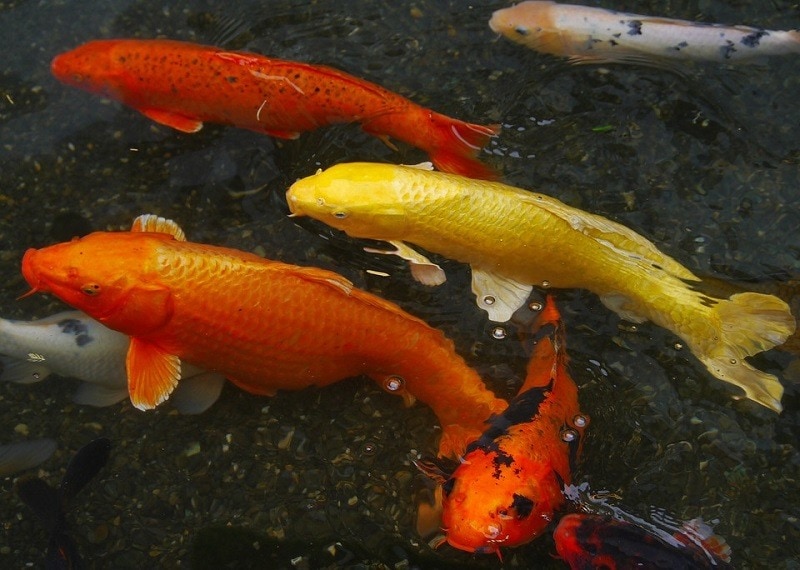
Are Koi Fish Good Tank Mates?
Koi fish are peaceful and friendly animals, so cohabitation with other species is not a problem. Koi fish are a gregarious species that likes to swim in shoals. It does not attack its congeners or even other species of fish. It is possible to mix your carp with other pond fish, such as tench or sturgeon.
What to Feed Your Koi Fish
Koi are omnivorous fish. The more their living conditions in the basin are optimal, the more they will develop and reproduce. Quality food will have beneficial effects on their health and growth, but also on the quality of the water. Feed your koi at regular times and in the same place in the pond. This consistency will allow you to get used to your carp and even be able to feed them by hand with a little patience.
As soon as the water temperature drops below 45°F, stop feeding your koi; they will go into hibernation at the bottom of the pond.
- Tip: Feeding your fish at regular times is also a way to spot suffering individuals. Koi are quite voracious by nature. If one of them doesn’t show up when you feed, it could be a sign of stress or illness. But wait 24 hours before taking action since a fish may not be very active one day and regain vigor the next.
Keeping Your Koi Fish Healthy
When a koi is sick, different treatments are available. But before you call your vet, you should place your koi in quarantine outside the pond so that it does not infect other fish.
- Large variations in water quality decrease their resistance, which allows diseases to develop. Regularly check and measure the quality of the water. It’s very easy with a water tester.
- To maintain optimal water quality, a good filter is necessary. The residual waste in the water is thus absorbed. If the filter also contains activated carbon, it can filter pathogens from the water.
- To avoid having sick fish in the spring, it is important to give them good quality food in the summer that contains all the essential nutrients like vitamins and minerals.
- Don’t add too many koi in your pond. Make sure you have a minimum of 200 gallons of water per koi.
Breeding
In the wild, what indicates that koi can reproduce is not their age but their size. However, there is an age group of sexual maturity: between three and five years for females and between two and three years for males. Thus, they must exceed 12 inches to reach sexual maturity. To breed your koi naturally, you need to have more males than females: around two to three males for a single female.
It is also advisable to feed the females well before the reproduction phase to be in perfect health. During the breeding season, males are easily distinguished from females. The male is slender and covered with small growths called marriage buds on the gills, around the eyes, and on the pectoral fins. The female has a very swollen abdomen.
When the female is in a sufficiently dense place with vegetation, she deposits her eggs there. The male’s sperm will then fertilize them. The fry hatch in 3 days to a week, depending on the environmental conditions and especially the temperature. The warmer the water, the earlier the birthing.
Once hatched, newborns can survive for a few days on their energy reserves, so there is no need to feed them. They then remain attached to the aquatic plants. After 2 or 3 days, fry take ownership of their surroundings and begin to swim actively. They also start to forage for food by eating the tiny, microscopic organisms and material in the water.
Are Koi Fish Suitable For Your Aquarium?
Koi fish can only be kept outdoors in ponds. They are unable to survive in an aquarium because a minimum of 200 gallons of water is required per adult koi. If you follow all the tips in this guide, you will ensure that your koi fish are thriving, healthy, and stay with you for many years to come.
See also:
Featured Image Credit: Mikro Graul, Shutterstock




